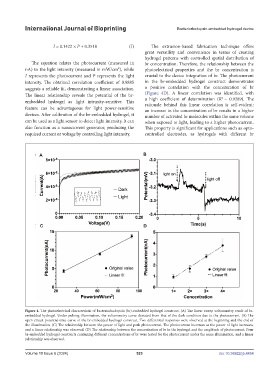Page 531 - IJB-10-6
P. 531
International Journal of Bioprinting Bacteriorhodopsin-embedded hydrogel device
I = 0.1422 × P + 0.3518 (I) The extrusion-based fabrication technique offers
great versatility and convenience in terms of creating
hydrogel patterns with controlled spatial distribution of
The equation relates the photocurrent (measured in br concentration. Therefore, the relationship between the
nA) to the light intensity (measured in mW/cm²), while photoelectrical properties and the br concentration is
I represents the photocurrent and P represents the light crucial to the device integration of br. The photocurrent
intensity. The obtained correlation coefficient of 0.9885 in the br-embedded hydrogel construct demonstrates
suggests a reliable fit, demonstrating a linear association. a positive correlation with the concentration of br
The linear relationship reveals the potential of the br- (Figure 4D). A linear correlation was identified, with
2
embedded hydrogel as light intensity-sensitive. This a high coefficient of determination (R = 0.9289). The
rationale behind this linear correlation is self-evident:
feature can be advantageous for light power-sensitive an increase in the concentration of br results in a higher
devices. After calibration of the br-embedded hydrogel, it number of activated br molecules within the same volume
can be used as a light sensor to detect light intensity. It can when exposed to light, leading to a higher photocurrent.
also function as a nanocurrent generator, producing the This property is significant for applications such as opto-
required current or voltage by controlling light intensity. controlled electrodes, as hydrogels with different br
Figure 4. The photoelectrical characteristic of bacteriorhodopsin (br)-embedded hydrogel construct. (A) The linear sweep voltammetry result of br-
embedded hydrogel. Under pulsing illumination, the voltammetry curve deviated from that of the dark condition due to the photocurrent. (B) The
open circuit potential-time curve of the br-embedded hydrogel construct. Two differential responses were observed at the beginning and the end of
the illumination. (C) The relationship between the power of light and peak photocurrent. The photocurrent increases as the power of light increases,
and a linear relationship was observed. (D) The relationship between the concentration of br in the hydrogel and the amplitude of photocurrent. Four
br-embedded hydrogel constructs containing different concentrations of br were tested for the photocurrent under the same illumination, and a linear
relationship was observed.
Volume 10 Issue 6 (2024) 523 doi: 10.36922/ijb.4454

